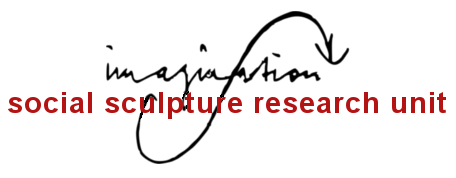Social Sculpture Forum, UK 1991-1998
Evolution of the Social Sculpture Research Unit Read More


Its core impulses, commitments and concerns link it to the ideas and insights of Joseph Beuys, Rudolf Steiner, Goethe and Schiller as well as to Gandhi, Tagore, Ivan Illich, Joanna Macy, James Hillman, John Dewey, Hannah Arendt, Arne Naess, Vandana Shiva and Arthur Zajonc. It sits within the liberatory stream of ‘free university’ and ‘free school’ initiatives across the world.
It has close affinities with many movements, approaches and fields. These include Goethean and other forms of phenomenology, post-growth economics, direct democracy, the basic income movement, commoning, the renewable energy movement, anarco-activism and self-organisation, organisational change for ecological and social justice, deep ecology and the enlivenment movement, eco-psychology, relating knowledge from the contemplative traditions to secular society, and in the arts, with Fluxus, actions and performance art, forum theatre, direct action interventions, the eco-art movement and other forms of connective aesthetics. It is connected in spirit to the permaculture movement and the sustainability thinking of those like E.F Schumacher with his call to develop ‘the culture of the inner human being’.
The SSRU was launched in 1998 at Oxford Brookes University at a gathering of over 150 people, which included Richard Hamilton, John Latham, Barbara Steveni, Platform members and many Arts Council and NGO representatives. Caroline Tisdall and Johannes Stuettgen opened the SSRU. Both spoke about its position in relation to Beuys’ work and the evolving field of social sculpture. Caroline emphasised the importance of bringing the social sculpture questions and insights into a university and Johannes highlighted the connection between social sculpture as an ‘expanded conception of art’ and direct democracy, self-determination and education.
The principles and practices that Shelley Sacks had been developing for sometime in the field of social sculpture were now integrated into a new ‘fine art’ curriculum that she had been appointed to develop… a curriculum that the School of Art, Publishing and Music at Oxford Brookes University saw as offering a genuinely interdisciplinary approach to art and art pedagogy for the 21 century.
This programme – which focused on ‘creative strategies’ and ‘imagination’ for developing ‘agency’ and an ‘engaged and transformative contemporary practice’ – drew on a perspective central to the field of social sculpture: that ‘every human being is an artist’ called upon to find and shape new, viable ways of being in the world, to develop the capacities to do this, and to transform the conditions that cause unnecessary suffering to the planet and all life forms.
This ethos and the practices that derive from it shaped the Masters and Doctoral programme in Social Sculpture at Oxford Brookes, as well as publications that share and disseminate these pedagogies and practices. This was envisaged as and has become an important dimension of the SSRU’s work.
Coinciding with the launch of the SSRU, the Exchange Values social sculpture project was installed for 3 months in the Arena at Oxford Brookes. Through numerous public fora, as well as work with school groups, citizens and NGOs, the project – now at its 4th venue – was an opportunity to present the social sculpture methodologies and ideas in practice, to the university and the local community.
Evolution of the Social Sculpture Research Unit Read More
The international interest collective created by Joseph Beuys in the 1970s to further social sculpture Read More
Actions and projects of the FIU branch in South Africa from 1977- 1983 Read More
Coming soon Read More